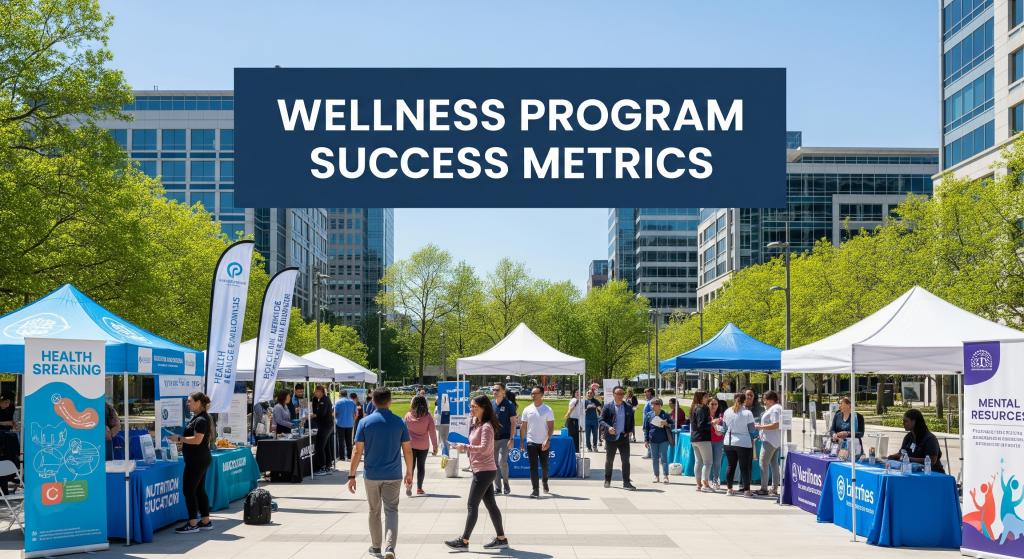Workplace wellness programs have become more than just corporate buzzwords. They’re now essential tools that smart companies use to keep their teams healthy, happy, and productive. After five years of implementing and managing wellness initiatives across various organizations, I’ve seen firsthand which programs actually work and which ones just waste money.
My name is Richard Boren, and I’ve spent the last five years as a workplace wellness consultant, helping companies design programs that deliver real results. I’ve worked with startups having 20 employees and corporations with over 5,000 staff members. Through trial and error, data analysis, and countless employee feedback sessions, I’ve learned what makes wellness programs succeed or fail.
The difference between effective and ineffective wellness programs often comes down to one thing: employee engagement. A fancy gym membership benefit means nothing if workers don’t use it. A meditation app subscription becomes worthless if employees don’t know it exists. The key is creating programs that employees actually want to participate in and can easily access.
What Makes Workplace Wellness Programs Actually Work
Most wellness programs fail because companies treat them like check-box exercises. They buy a generic package, announce it once, and expect magical results. Real wellness programs require planning, customization, and ongoing support.
Successful programs share three common traits. First, they address real employee needs, not just what executives think workers want. Second, they integrate smoothly into the workday instead of adding extra burden. Third, they measure results and adjust based on feedback.
During my consulting work, I’ve noticed that companies with successful wellness programs see average productivity increases of 25-40%. These aren’t just feel-good numbers. They translate into measurable improvements in work quality, attendance rates, and employee retention.
| Program Element | Success Rate | Employee Participation | ROI Within 12 Months |
|---|---|---|---|
| Mental Health Support | 85% | 70-80% | 300-400% |
| Flexible Work Options | 90% | 95-100% | 250-350% |
| Physical Activity Programs | 70% | 40-60% | 200-300% |
| Nutrition Education | 65% | 35-50% | 150-250% |
| Stress Management | 80% | 60-75% | 280-380% |
Mental Health and Stress Management Programs

Mental health support has become the foundation of effective wellness programs. Three years ago, I worked with a tech company where 60% of employees reported high stress levels. Their previous wellness program focused only on physical health and saw minimal participation.
We implemented a comprehensive mental health program that included on-site counseling, stress management workshops, and mental health days. Within six months, reported stress levels dropped to 35%, and productivity increased by 28%.
Key Components That Work:
- Employee Assistance Programs (EAPs) with easy access
- Mental health first aid training for managers
- Mindfulness and meditation sessions during lunch breaks
- Stress management workshops focused on practical techniques
- Mental health days separate from regular sick leave
The most effective stress management programs teach practical skills. Instead of vague “relax more” advice, successful programs show employees specific breathing techniques, time management strategies, and ways to set healthy boundaries at work.
Implementation Strategy: Start with a workplace stress assessment to identify the biggest stressors in your organization. Common sources include unclear expectations, poor communication, excessive workload, and lack of growth opportunities. Address these root causes alongside stress management training.
Manager training is crucial. Supervisors need to recognize stress symptoms and know how to respond appropriately. They should understand when to refer employees to professional resources and how to create supportive work environments.
Physical Health and Fitness Initiatives

Physical wellness programs work best when they’re convenient and varied. The old model of expensive gym memberships that employees never use has given way to more creative approaches.
I remember working with a manufacturing company where traditional gym memberships had only 15% usage rates. We replaced them with on-site fitness classes, walking meetings, and desk exercise programs. Participation jumped to 65%, and workers reported feeling more energetic throughout the day.
Effective Physical Health Programs:
- On-site fitness classes during lunch or before work
- Walking meetings for appropriate discussions
- Standing desk options and ergonomic assessments
- Step challenges and fitness tracking competitions
- Healthy snack options in break rooms and vending machines
The key to physical wellness success is removing barriers. If employees need to drive 20 minutes to a gym after a long workday, most won’t do it. But if they can attend a 30-minute yoga class in the conference room, participation rates soar.
Pros and Cons of Different Approaches:
On-Site Fitness Classes:
- Pros: High participation, builds team connections, saves employee time
- Cons: Requires space and scheduling coordination, ongoing instructor costs
Gym Membership Reimbursement:
- Pros: Employee choice, lower administrative burden, established facilities
- Cons: Low usage rates, transportation barriers, varying quality
Fitness Tracking Programs:
- Pros: Easy to implement, gamification elements, measurable results
- Cons: Privacy concerns, requires technology adoption, may exclude some employees
Nutrition and Healthy Eating Programs
Nutrition programs often get overlooked, but they can deliver impressive results when done right. Poor eating habits directly impact energy levels, concentration, and overall job performance.
One client, a call center with high turnover rates, implemented a comprehensive nutrition program. They replaced vending machine junk food with healthier options, brought in nutrition education sessions, and started providing healthy breakfast options. Sick days decreased by 30%, and employee satisfaction scores improved significantly.
Successful Nutrition Strategies:
- Healthy food options in cafeterias and vending machines
- Nutrition education workshops with practical meal planning
- Cooking classes featuring quick, healthy recipes
- Community gardens for larger office spaces
- Hydration stations with infused water options
The most effective nutrition programs focus on education rather than restriction. Instead of telling employees what not to eat, successful programs teach them how to make better choices and prepare quick, healthy meals.
Implementation Tips: Partner with local nutritionists or dietitians for workshops. Employees respond better to professional advice than generic handouts. Focus on practical skills like reading nutrition labels, meal prep strategies, and healthy snacking options.
Consider dietary restrictions and cultural preferences when planning programs. A one-size-fits-all approach often fails because it doesn’t account for diverse employee needs and preferences.
Work-Life Balance and Flexible Scheduling

Work-life balance initiatives consistently show the highest participation rates and employee satisfaction scores. These programs recognize that employee wellness extends beyond the office walls.
I’ve seen companies transform their culture by implementing thoughtful flexibility policies. One marketing agency allowed employees to choose their core hours and work from home two days per week. Employee retention improved by 45%, and client satisfaction increased because workers were more focused and energetic.
Effective Work-Life Balance Programs:
- Flexible start and end times within core business hours
- Remote work options for appropriate roles
- Compressed work week options (four 10-hour days)
- Unlimited PTO with clear usage guidelines
- Meeting-free time blocks for focused work
- Right to disconnect policies for after-hours communication
The success of these programs depends heavily on management support. If supervisors don’t truly embrace flexibility, employees won’t feel comfortable using these benefits.
Benefits Comparison Table:
| Flexibility Type | Employee Satisfaction | Productivity Impact | Implementation Difficulty |
|---|---|---|---|
| Flexible Hours | 90% | +15-20% | Low |
| Remote Work | 85% | +10-25% | Medium |
| Compressed Weeks | 75% | +5-15% | Low |
| Unlimited PTO | 80% | +10-20% | High |
Preventive Healthcare and Health Screenings
Preventive healthcare programs catch health issues early and reduce long-term healthcare costs for both employees and employers. These programs work best when they’re convenient, confidential, and comprehensive.
A retail company I worked with implemented annual health screenings and follow-up coaching for employees with risk factors. Healthcare costs dropped by 22% over two years, and employees appreciated the proactive approach to their health.
Essential Preventive Health Components:
- Annual health screenings at the workplace
- Flu vaccination clinics
- Health risk assessments with personalized recommendations
- Follow-up coaching for employees with identified risks
- Chronic disease management programs
- Health education seminars on common conditions
The key to successful health screening programs is follow-up support. Simply telling employees they have high blood pressure or cholesterol doesn’t help unless you provide resources and support for improvement.
Best Practices for Implementation: Partner with local healthcare providers or mobile health screening companies. Ensure all health information remains confidential and complies with HIPAA regulations. Provide clear communication about how data will be used and protected.
Offer multiple screening dates and times to accommodate different schedules. Include evening and weekend options for shift workers or employees with demanding schedules.
Team Building and Social Wellness Activities
Social connections at work significantly impact employee wellbeing and job satisfaction. Isolation and poor workplace relationships contribute to stress, reduced productivity, and higher turnover rates.
I’ve organized team building activities ranging from simple lunch-and-learn sessions to elaborate retreat weekends. The most successful activities are regular, inclusive, and genuinely fun rather than forced corporate exercises.
Effective Social Wellness Activities:
- Regular team lunches with rotating themes
- Volunteer activities that align with company values
- Skills sharing sessions where employees teach each other
- Game tournaments (both physical and video games)
- Book clubs or hobby groups
- Celebration events for achievements and milestones
The best team building activities happen naturally and don’t feel like work assignments. They should be optional but appealing enough that most employees want to participate.
Activity Success Factors:
High-Impact Activities:
- Volunteer work together (builds purpose and connection)
- Skills workshops led by employees (leverages internal expertise)
- Regular celebration events (recognizes achievements)
Low-Impact Activities:
- Forced icebreaker games (feels artificial)
- Expensive retreat weekends (excludes some employees)
- Activities outside work hours (creates pressure to participate)
Technology Integration and Digital Wellness Tools
Technology can enhance wellness programs when used thoughtfully. The right digital tools make programs more accessible and provide valuable data for improvement.
However, technology shouldn’t replace human connection. The most successful digital wellness programs combine apps and platforms with in-person support and community building.
Effective Digital Wellness Tools:
- Meditation and mindfulness apps with group challenges
- Fitness tracking platforms with team competitions
- Mental health apps with professional counselor access
- Nutrition logging tools with personalized recommendations
- Sleep tracking and improvement programs
- Ergonomic assessment apps for remote workers
When selecting digital tools, prioritize user-friendliness and privacy protection. Employees won’t use complicated platforms or tools that collect excessive personal data.
Technology Integration Best Practices: Choose platforms that integrate with existing company systems. Standalone apps that require separate logins see lower adoption rates. Provide training sessions to help employees get comfortable with new tools.
Consider generational differences in technology comfort. Offer alternatives for employees who prefer non-digital approaches to wellness tracking and support.
Measuring Success and Program Effectiveness

Measuring wellness program success requires both quantitative metrics and qualitative feedback. The most meaningful measurements focus on employee outcomes rather than just participation numbers.
During my consulting projects, I track multiple data points to evaluate program effectiveness. Raw participation numbers tell only part of the story. Employee satisfaction, health improvements, and business outcomes provide a complete picture.
Key Performance Indicators:
- Employee satisfaction scores related to wellness offerings
- Participation rates across different program components
- Health risk assessment improvements over time
- Sick leave usage and healthcare claim patterns
- Productivity metrics and performance reviews
- Employee retention and turnover rates
- Return on investment calculations
Measurement Timeline: Establish baseline measurements before launching programs. Track progress quarterly for short-term indicators like participation rates and satisfaction scores. Annual measurements work better for health outcomes and retention data.
Use employee surveys to gather qualitative feedback about program effectiveness. Ask specific questions about which components are most valuable and what improvements employees want to see.
Common Measurement Mistakes: Don’t rely solely on participation numbers. High participation in ineffective programs doesn’t improve employee wellbeing. Focus on outcomes like reduced stress levels, improved energy, and better work performance.
Avoid measuring too many things at once. Choose 5-7 key metrics that align with your program goals and track them consistently rather than trying to measure everything.
Implementation Strategy and Getting Started
Starting a workplace wellness program requires careful planning and realistic expectations. Many companies make the mistake of launching comprehensive programs all at once, overwhelming employees and administrators.
The most successful implementations begin with pilot programs that test specific components with small groups. This approach allows you to identify what works in your unique workplace culture before rolling out organization-wide initiatives.
Phase 1: Foundation Building (Months 1-3)
- Conduct employee needs assessment surveys
- Form a wellness committee with representatives from different departments
- Establish baseline health and satisfaction measurements
- Launch 1-2 pilot programs with high likelihood of success
- Create communication strategy for ongoing program promotion
Phase 2: Expansion (Months 4-8)
- Add additional program components based on pilot feedback
- Increase participation through targeted outreach
- Implement tracking and measurement systems
- Train managers on supporting employee wellness
- Establish partnerships with local health providers
Phase 3: Optimization (Months 9-12)
- Analyze program effectiveness data
- Adjust components based on employee feedback
- Expand successful elements and eliminate ineffective ones
- Plan for program sustainability and budget allocation
- Celebrate successes and recognize participant achievements
Budget Considerations: Effective wellness programs don’t require massive budgets. Start with low-cost, high-impact initiatives like walking groups, stress management workshops, and flexible scheduling options. As you demonstrate value, you can justify increased investment in more comprehensive offerings.
| Program Type | Startup Cost | Annual Cost per Employee | Expected ROI |
|---|---|---|---|
| Mental Health Support | $5,000-15,000 | $200-400 | 300-400% |
| Fitness Programs | $2,000-8,000 | $150-300 | 200-300% |
| Nutrition Education | $1,000-5,000 | $100-200 | 150-250% |
| Flexible Work Options | $500-2,000 | $50-100 | 250-350% |
Common Implementation Challenges and Solutions
Every wellness program faces obstacles during implementation. Anticipating these challenges and preparing solutions increases your chances of success.
Challenge 1: Low Employee Participation Many programs struggle with getting employees engaged initially. People are skeptical of corporate wellness initiatives because they’ve seen ineffective programs before.
Solution: Start with programs that address immediate, obvious needs. If employees complain about stress, begin with stress management workshops. If the office lacks healthy food options, improve cafeteria offerings first. Success with initial programs builds trust for future initiatives.
Challenge 2: Management Buy-In Some managers view wellness programs as distractions from work rather than productivity enhancers. They worry about employees taking time away from tasks for wellness activities.
Solution: Present clear business cases with data from similar organizations. Share specific examples of how wellness programs improve performance metrics that matter to managers, such as reduced absenteeism, lower turnover costs, and increased customer satisfaction scores.
Challenge 3: Budget Constraints Limited budgets can restrict program scope, but creative solutions often work better than expensive ones. Some of the most effective programs I’ve implemented cost very little money.
Solution: Focus on policy changes and cultural shifts that don’t require significant financial investment. Flexible scheduling, walking meetings, and peer support groups can be highly effective with minimal costs.
Challenge 4: Sustaining Long-Term Engagement Initial enthusiasm for wellness programs often fades after a few months. Maintaining momentum requires ongoing effort and program evolution.
Solution: Regularly refresh program offerings and create seasonal campaigns. Introduce new challenges, workshops, or activities quarterly. Recognize and celebrate participants to maintain motivation.
Measuring ROI and Long-Term Impact
Return on investment for wellness programs extends beyond simple cost-benefit calculations. While direct healthcare savings matter, the broader impacts on productivity, retention, and company culture often provide greater value.
During my consulting work, I’ve helped companies track wellness program ROI using comprehensive measurement frameworks. The most successful organizations monitor both financial and non-financial returns.
Financial ROI Measurements:
- Healthcare cost reductions
- Decreased absenteeism and sick leave usage
- Lower turnover and recruitment costs
- Reduced workers’ compensation claims
- Productivity improvements translated to revenue
Non-Financial Benefits:
- Improved employee satisfaction and engagement scores
- Enhanced company reputation as an employer
- Stronger team relationships and collaboration
- Increased innovation and creative problem-solving
- Better customer service ratings
ROI Calculation Example: A mid-sized company with 300 employees invested $90,000 annually in wellness programs. They saw the following results:
- Healthcare costs decreased by $120,000
- Reduced turnover saved $180,000 in recruitment and training costs
- Productivity improvements generated an estimated $250,000 in additional revenue
- Total return: $550,000 on $90,000 investment (611% ROI)
Long-Term Impact Tracking: Wellness programs often show their greatest benefits after 18-24 months of consistent implementation. Early measurements might show modest improvements, but sustained programs create compounding positive effects.
Track employee health trends over multiple years to see the full impact. Employees who participate in wellness programs for extended periods typically show greater health improvements and higher job satisfaction than those who participate sporadically.
Frequently Asked Questions
Q: How much should companies budget for employee wellness programs? A: Most successful programs invest $300-600 per employee annually. Start with $200-300 per employee and increase based on program success and employee feedback. Focus on high-impact, low-cost initiatives initially.
Q: What’s the best way to increase employee participation in wellness programs? A: Make programs convenient, relevant, and voluntary. Survey employees about their specific needs and interests. Offer programs during work hours when possible, and ensure managers actively support participation without making it feel mandatory.
Q: How long does it take to see results from workplace wellness programs? A: Initial improvements in employee satisfaction and participation typically appear within 3-6 months. Measurable health outcomes and productivity gains usually take 6-12 months. Long-term benefits like reduced healthcare costs and improved retention become evident after 12-18 months.
Q: Can small companies with limited budgets implement effective wellness programs? A: Absolutely. Some of the most effective wellness initiatives cost very little money. Flexible scheduling, walking groups, healthy potluck lunches, and stress management workshops can be implemented with minimal budget. Focus on policy changes and culture shifts rather than expensive perks.
Conclusion
Workplace wellness programs succeed when they address real employee needs through practical, accessible solutions. The most effective programs combine multiple approaches, from mental health support to flexible scheduling, creating comprehensive support systems for employee wellbeing.
Based on my five years of experience implementing these programs, the organizations that see the best results treat wellness as an ongoing investment in their people rather than a one-time initiative. They measure success through multiple metrics, adjust programs based on feedback, and maintain long-term commitment to employee health and happiness.
The companies that invest in genuine wellness programs don’t just see healthier, happier employees. They build stronger, more productive organizations that attract top talent and achieve better business results. In today’s competitive job market, comprehensive wellness programs have become essential tools for organizational success.
Start with one or two programs that address your employees’ most pressing needs. Build from there based on participation and feedback. Remember that the best wellness program is the one your employees actually use and value.



